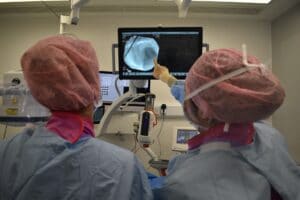Further Details about Cardiology Assessments
Echocardiography is used to assess the structure and physiology of the heart. It utilises non-harmful sound-waves to produce images of the heart and blood flow. It is best performed in conjunction with other assessments of heart disease and cardiologists interpret findings with echocardiography in the context of a physical examination, medical history and, usually, radiographs. Echocardiography is best performed by experienced cardiologists with a high level of expertise in interpretation.
A ‘heart murmur’ is a sound usually caused by turbulent blood flow within the heart and detected by a vet after listening to your cat’s chest with a stethoscope. Most cats with heart murmurs have heart disease, but occasionally murmurs turn out not to be related to significant heart problems. The murmur itself doesn’t tell us how severe a heart problem is or whether it needs treatment. Sometimes disease doesn’t need treatment but may do in the future. Many excellent treatments exist for cats and dogs with heart disease, but knowing which patients benefit from these is at the core of cardiology.
Your puppy can be assessed in one of our clinics. The positive findings of these clinics are that your puppy doesn’t have an underlying problem and they can go home, however we might ask your local vet to monitor their heart murmur.
Patent Ductus Arteriosus (PDA) is a congenital heart defects in dogs. The ductus arteriosus is the gap between the pulmonary artery and the aorta (two major vessels leaving the heart). In a normal heart, blood from the whole body enters the right side of the heart and is pumped into the lungs through the pulmonary artery. After receiving oxygen in the lungs this blood returns to the left side of the heart and is then pumped into the whole body through the aorta. Before birth, when the lungs aren’t working the ductus arteriosus diverts the blood from the pulmonary artery straight into the aorta. Shortly after birth the ductus arteriosus should close completely to direct all the blood through the lungs. However sometimes it doesn’t close, and the blood will flow from the aorta through the patent ductus arteriosus back into the pulmonary artery. When the PDA doesn’t close, the left side of the heart gets too much blood and has to work harder than usual and might ultimately lead to congestive heart failure as there is too much blood consistently coming back to the left side of the heart.
If a Patent Ductus Arteriosus (PDA) isn’t treated in these puppies then approximately 60% of affected dogs will die within their first year. In the vast majority, this will lead to a laboured and accelerated breathing pattern and lethargy. In some patients, the stretch of the left side of the heart can lead to possibly malignant arrhythmias that again can lead to lethargy, fainting and in the worst-case scenario, be fatal.
Pulmonic Stenosis (PS) is a common congenital heart defects in dogs. It consists of a malformation of the pulmonic valve leading to obstruction of the flow of blood from the heart into the lungs.
If Pulmonic Stenosis isn’t treated in these puppies then, depending on the severity of the narrowing, the right side of the heart could eventually fail as it has to contract against a much higher resistance than is usually the case. Also, the heart can develop severe heart rhythm disturbances that may lead to lethargy, fainting and in the worst-case scenario can even be fatal.
A ACDO remains in place for life, here are photos of a puppy with a Patent Ductus Arteriosus - A condition where the opening between the two major blood vessels leading from the heart fails to close after birth - If a PDA isn’t closed then the dog will experience heart failure as the heart gets bigger and this is usually before a year old.
To see a video of this being undertaken please click here.



The puppy is being scanned for an investigation of a heart murmur.
